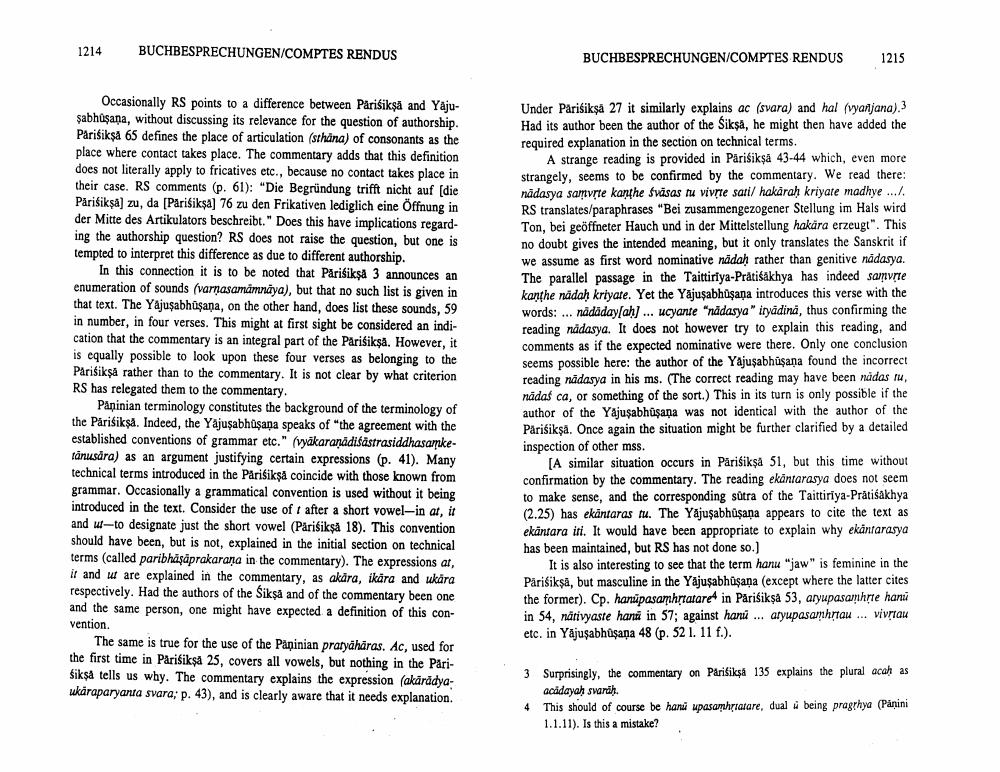Book Title: Buchbesprechungen Comptes Rendus Author(s): Johannes Bronkhorst Publisher: Johannes Bronkhorst View full book textPage 3
________________ 1214 BUCHBESPRECHUNGEN/COMPTES RENDUS BUCHBESPRECHUNGEN/COMPTES RENDUS 1215 Occasionally RS points to a difference between Parisikş and Yajusabhusana, without discussing its relevance for the question of authorship. Parisiksa 65 defines the place of articulation (sthdna) of consonants as the place where contact takes place. The commentary adds that this definition does not literally apply to fricatives etc., because no contact takes place in their case. RS comments (p. 61): "Die Begründung trifft nicht auf (die Pårifiksa) zu, da (Parisikşa) 76 zu den Frikativen lediglich eine Offnung in der Mitte des Artikulators beschreibt." Does this have implications regarding the authorship question? RS does not raise the question, but one is tempted to interpret this difference as due to different authorship. In this connection it is to be noted that Parisiksa 3 announces an enumeration of sounds (varnasamannaya), but that no such list is given in that text. The Yajuşabhusana, on the other hand, does list these sounds, 59 in number, in four verses. This might at first sight be considered an indication that the commentary is an integral part of the Parisikşa. However, it is equally possible to look upon these four verses as belonging to the Parisikşå rather than to the commentary. It is not clear by what criterion RS has relegated them to the commentary. Paninian terminology constitutes the background of the terminology of the Parisiksa. Indeed, the Yajuşabhüşana speaks of the agreement with the established conventions of grammar etc." (vyakaranádiśästrasiddhasanketanusára) as an argument justifying certain expressions (p. 41). Many technical terms introduced in the Parisikşå coincide with those known from grammar. Occasionally a grammatical convention is used without it being introduced in the text. Consider the use of after a short vowel-in ar, i and w-to designate just the short vowel (Parisiksa 18). This convention should have been, but is not, explained in the initial section on technical terms (called paribhasprakarana in the commentary). The expressions ar, it and w are explained in the commentary, as akára, ikära and ukara respectively. Had the authors of the Siksa and of the commentary been one and the same person, one might have expected a definition of this convention. The same is true for the use of the Papinian pratyähäras. Ac, used for the first time in Parisiksa 25, covers all vowels, but nothing in the PariSiksa tells us why. The commentary explains the expression (akärádya ukaraparyanta svara; p. 43), and is clearly aware that it needs explanation Under Parisiksa 27 it similarly explains ac (svara) and hal vyanjana). Had its author been the author of the Sikşa, he might then have added the required explanation in the section on technical terms. A strange reading is provided in Parisikşă 43-44 which, even more strangely, seems to be confirmed by the commentary. We read there: nadasya samvrte kanthe vasas tu vivre sari/ hakarah kriyate madhye .../. RS translates/paraphrases "Bei zusammengezogener Stellung im Hals wird Ton, bei geöffneter Hauch und in der Mittelstellung hakára erzeugt". This no doubt gives the intended meaning, but it only translates the Sanskrit if we assume as first word nominative nddah rather than genitive nadasya. The parallel passage in the Taittiriya-Pratisakhya has indeed samvrte kanthe nädah kriyate. Yet the Yajuşabhusana introduces this verse with the words: ... nädāday[ah) ... cyante "nadasya" iryadina, thus confirming the reading nådasya. It does not however try to explain this reading, and comments as if the expected nominative were there. Only one conclusion seems possible here: the author of the Yajusabhūşana found the incorrect reading nadasya in his ms. (The correct reading may have been nadas tu, nadas ca, or something of the sort.) This in its turn is only possible if the author of the Yajuşabhusana was not identical with the author of the Parisikşa. Once again the situation might be further clarified by a detailed inspection of other mss. (A similar situation occurs in Parisikşå 51, but this time without confirmation by the commentary. The reading ekántarasya does not seem to make sense, and the corresponding sutra of the Taittiriya-Pratisakhya (2.25) has ekantaras tu. The Yajuşabhüşana appears to cite the text as ekäntara ini. It would have been appropriate to explain why ekantarasya has been maintained, but RS has not done so.) It is also interesting to see that the term hanu "jaw" is feminine in the Parisiksa, but masculine in the Yajusabhusana (except where the latter cites the former). Cp, hanūpasamhstatare in Parisiksa 53, aryupasamhrte hani in 54, näri vyaste hana in 57; against hanu ... atyupasamhrtau ... vivstau etc. in Yajusabhūşana 48 (p. 52 1. 11 f.). 3 Surprisingly, the commentary on Parifiksa 135 explains the plural acah as acidayah svarar This should of course be har upasanhiatare, dual being pragthya (Panini 1.1.11). Is this a mistake? 4Page Navigation
1 2 3 4 5 6 7 8
